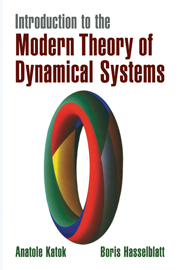0 - INTRODUCTION
Published online by Cambridge University Press: 05 June 2012
Summary
Principal branches of dynamics
The most general and somewhat vague notion of a dynamical system includes the following ingredients:
(i). A “phase space” X, whose elements or “points” represent possible states of the system.
(ii). “Time”, which may be discrete or continuous. It may extend either only into the future (irreversible or noninvertible processes) or into the past as well as the future (reversible or invertible processes). The sequence of time moments for a reversible discrete-time process is in a natural correspondence to the set of all integers; irreversibility corresponds to considering only nonnegative integers. Similarly, for a continuous-time process, time is represented by the set of all real numbers in the reversible case and by the set of nonnegative real numbers for the irreversible case.
(iii). The time-evolution law. In the most general setting this is a rule that allows us to determine the state of the system at each moment of time t from its states at all previous times. Thus, the most general time-evolution law is time dependent and has infinite memory. In the course of this book, however, we will consider only those evolution laws that allow us to define all future (and for reversible systems also past) states given a state at any particular moment. Furthermore we will assume that the law of time evolution itself does not change with time. In other words, the result of time evolution will depend only on the initial position of the system and on the length of the evolution but not on the moment when the state of the system was initially registered.
- Type
- Chapter
- Information
- Publisher: Cambridge University PressPrint publication year: 1995
- 1
- Cited by



